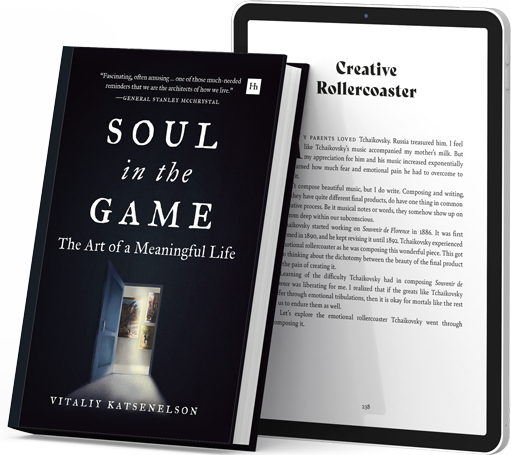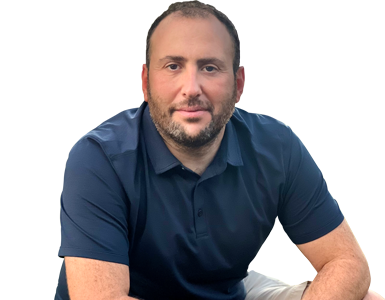Get the most out of
your book club reading
of Soul in the Game
club questions (or read below)
Not sure yet?
Get 3 sample chapters in your inbox:
Jacket cover summary:
Soul in the Game is a book of inspiring stories and hard-won lessons on how to live a meaningful life, crafted by investor and writer Vitaliy Katsenelson. Drawing from the lives of classical composers, ancient Stoics, and contemporary thinkers, Katsenelson weaves together a tapestry of practical wisdom that has helped him overcome his greatest challenges: in work, family, identity, and health – and in dealing with success, failure, and more.
Part autobiography, part philosophy, part creativity manual, Soul in the Game is a unique and vulnerable exploration of what works, and what doesn’t, in the attempt to shape a fulfilling and happy life.
Get 3 sample chapters in your inbox:

Want to meet Vitaliy?
Get invited to a zoom session with the book author where you’ll be able to chat and ask questions.

Book summary as it appears in the intro chapter:
How to Read This Book
If someone had suggested a decade ago that I would write a book that had nothing to do with value investing, I would have laughed. Even after writing two books on investing, I thought of myself as an investor who thinks through writing, not “a writer.” I preferred to leave that stuff to professionals – the Dostoevskys and Hemingways – and stick to what I knew best: value investing.
However, over the years, I brought “life” stories about my childhood, my kids, and classical music as supporting actors (often as analogies) onto the main stage of my writing about investing. Kids change you; the realization of your mortality changes you – and writing changes you. It was just a matter of time before these life stories wanted to grow out of their supporting roles into lead roles.
Thousands of emails from my readers had a lot to do with that, too. Readers wrote that they came for the articles about value investing but stayed for the life stories (and my father’s art; but more on that later). They encouraged me to turn my life (non-investment) essays into a book. They told me that reading these stories had made their lives a little better. Reading my essays nudged them to reflect on their own lives. Often, I even seemed to inspire them into action: to travel, to spend more time with their loved ones, or to just simply slow down and inhale life. This book is about the most important investment you’ll ever make: the investment in your life.
I hope a story or two in these “life” essays will touch you, add a ray or two of sunlight to your day, and motivate you to fill the gap in your life that needs filling.
This book is evergreen, and so I have structured it thematically, not chronologically (you will notice this in the variability of my kids’ ages throughout the book). It started out just as a collection of stories I’ve written over the years. But as I was editing it, the writer in me took over. I ended up completely rewriting old essays and writing many new ones. Though it is not a traditional book with a story arc running through it, it morphed into more than just a collection of random stories. It is written to be read in sequence.
The book is loosely organized into six sections:
The Student of Life section has an autobiographical character. It takes you to Soviet Russia for my childhood, the fear that my aunt was an American spy, my family’s emigration to the US, and our first (wonder) years in this great country.
Then it takes you on my most educational journey of all – being a parent. Those stories are full of joy and mistakes (kids don’t come with an instruction manual), but also growth. Being a parent is the most transformative experience of all.
This section also features “Soul in the Game,” an essay that provides a lens through which to view the rest of the book. It touches on everything one needs to find meaning in the creative part of their life. It is so important to me that I titled the book after it.
In Inhaling the World I share my experiences and impressions from visiting Santa Fe, San Francisco, Switzerland, France, and Italy with my family. I discuss topics ranging from how visiting a modern art museum can enhance your trip to an IKEA store, to Jeffersonian lunches, to the caloric content of uncooked fish. If this section inspires you to see a bit more of the world, I have succeeded.
One Day at a Time is the self-help part of this book. Well, kind of. I am not dispensing self-help advice; I am just taking you with me on my journey of learning about how to stick to a diet, sleep better, work out, meditate (a little), and firm up new habits through trial and (a lot of) error. I’ll share personal finance advice that was given to me by a friend when I got married – advice that eliminated any bickering about finances from my marriage!
I was almost done editing this book when I stumbled onto Stoic philosophy. I was so taken by it that I put editing on hold and embarked on a five-month learning and then writing journey about Stoicism. This spilled into Stoicism – The Philosophy For Life. It’s a mini-book within this book, with two sections of its own. One section focuses on Stoicism as an operating system for life, and the other outlines a value system that could lead you to a happier and more meaningful life.
Soul in Creativity houses my essays on… you guessed it, creativity. Creativity is a thread that runs throughout the whole book. I have found that creativity is a secret sauce that makes life more meaningful; it’s what draws me out of bed every morning.
I share with you what I’ve learned about the art and process of writing, not to mention how the music of AC/DC can turn you into a better writer. And you’ll learn how I structured my life to have time to run an investment firm, do investment research, spend time with my family, and still write the equivalent of a book a year.
The essay “Pain, Opera and Investing” explores an excruciatingly painful professional period in my life. Most importantly, it offers tools (based on Stoic philosophy) for coping with pain. This essay sat in my virtual drawer for years; I couldn’t bring myself to publish it, until now.
After I finished writing the essay “Creative Roller Coaster,” I realized that I had to take all my life essays and publish them as a book to share with others. There was an instigator who was single-handedly responsible for my starting to work on this book: Pyotr Ilyich Tchaikovsky. I explore Tchaikovsky’s struggles as a composer, which I can so relate to as a writer; though I get the feeling that this struggle is universal in all creative endeavors, not just composing and writing.
Tchaikovsky brings us to the last section, Melody of Life. In this series of essays, I delve into the lives of classical music titans –Tchaikovsky, Schubert, Liszt, Brahms, Chopin, Berlioz, and Bruckner.
Though these essays about classical music and composers may seem out of place in this book, they continue to tug on this thread of creativity. Today we listen to the music of these superstars, and it still moves us (to me it is the best drug of all). We call them geniuses. But their talent and success, which seems evident to us, was anything but evident to many of them. Just like the rest of us, they were full of insecurities and went through a lot of personal and creative struggles, accompanied by a lot of pain. There is a lot we can learn from them.
By way of summary and conclusion, in The Art of a Meaningful Life I collect the breadcrumbs I left throughout the book and connect the concept of soul in the game, Stoic philosophy, creativity, and lessons from classical music composers by means of an art and craft framework. Oh, and I break the fourth wall.
Finally, if you are questioning why a relatively young adult with plenty of life experiences still ahead of him writes an autobiographical book, read “Intermission – Stop Eating Sugar” (the book’s conclusion): It will answer this question.
My advice to you: Read this book as if each essay is an email that just appeared in your inbox. You are invited to ponder for a while before you move on.
For reasons that will become apparent as you read the next essay, I also had to include a few of my father’s paintings in this book. You can find them in the middle painting section. And you can always see more of his artwork at Katsenelson.com.
I approach this book the same way Zeno, the founder of Stoicism, approached his students. Zeno did not claim to be a physician – he saw himself as a patient describing the progress of his treatment to fellow patients in the hospital beds beside him. Grab a bed next to mine and let’s have a conversation about life, creativity, Stoic philosophy, classical music, and other fun topics.
Get 3 sample chapters in your inbox:
Book Club Questions
01
Soul in the Game is difficult to categorize.
What genre do you think it fits into? How would you describe it to a friend?
02
What did you think the book was going to be like before you
read it and how did your opinion change as you went along?
03
How was your experience reading Soul in the Game
given its non-linear, episodic structure?
04
What do you think of how it’s organized and the subjects covered?
05
What did you think of Vitaliy’s voice and writing style?
06
Vitaliy begins with sharing his life in the far north of Soviet Russia –
what did you think of his experience growing up and his immigration to the US?
07
Was there a chapter that made you think “This is written especially for me?”
If so, which was it and why?
08
Was there a chapter that you felt completely missed the mark
or failed to connect with you? Which one and why?
09
Parts of this book share life lessons – did any of them spur you into action
or cause you to change the way you do or think about things?
10
How did you feel after you finished the book?
Are there any questions Vitaliy touched on that you’re still thinking about?
11
Is there a topic you’d like the author to expand on or one
that he hasn’t covered altogether that you’d like him to discuss?
12
What is the most important idea or quote from this book?
13
Did Soul in the Game remind you of another book as you read?
14
Did you have to Google anything while reading this book?
15
Who do you want most to read this book?
Want to meet Vitaliy?
Get invited to a zoom session with the book author where you’ll be able to chat and ask questions.
